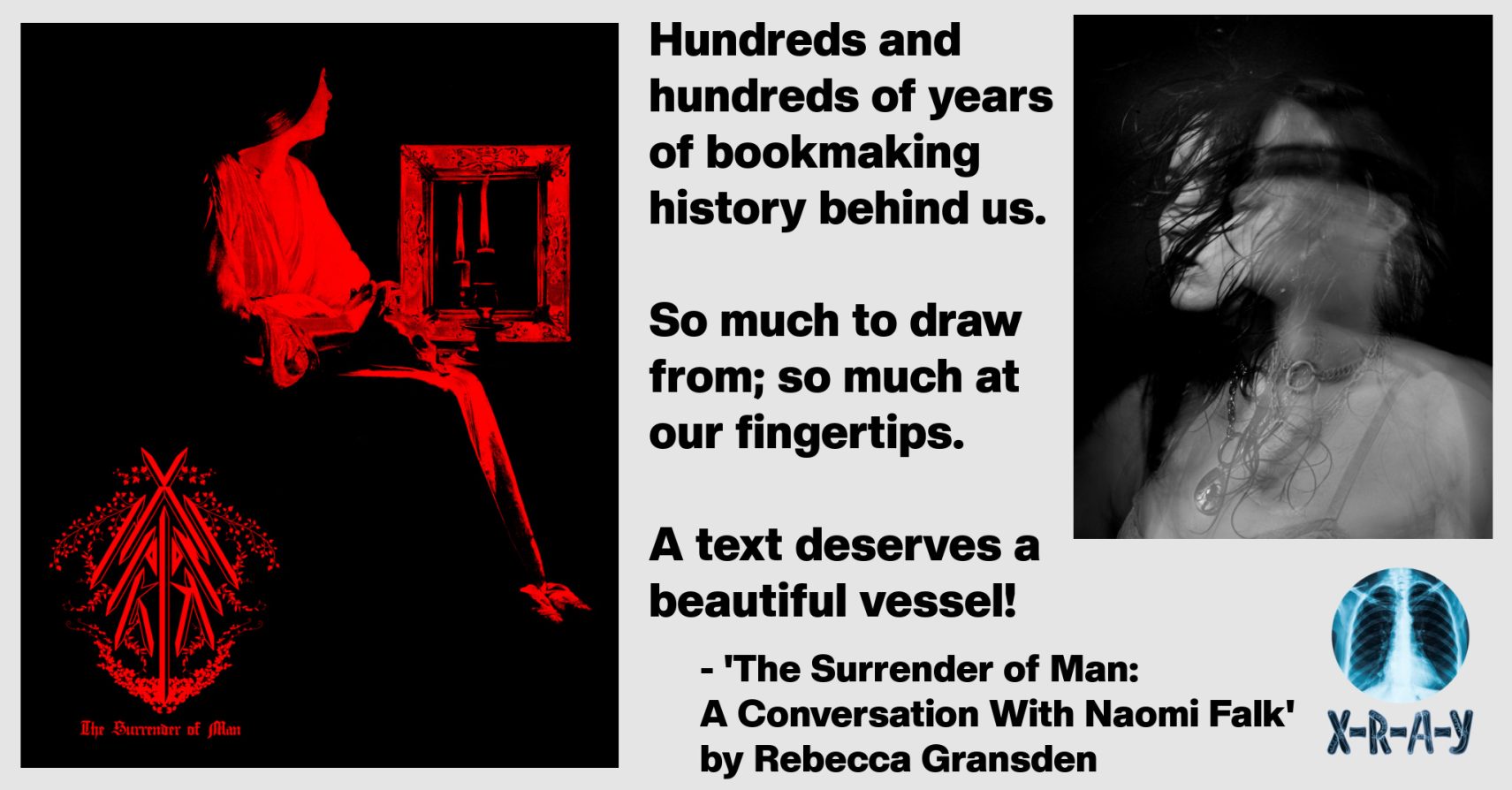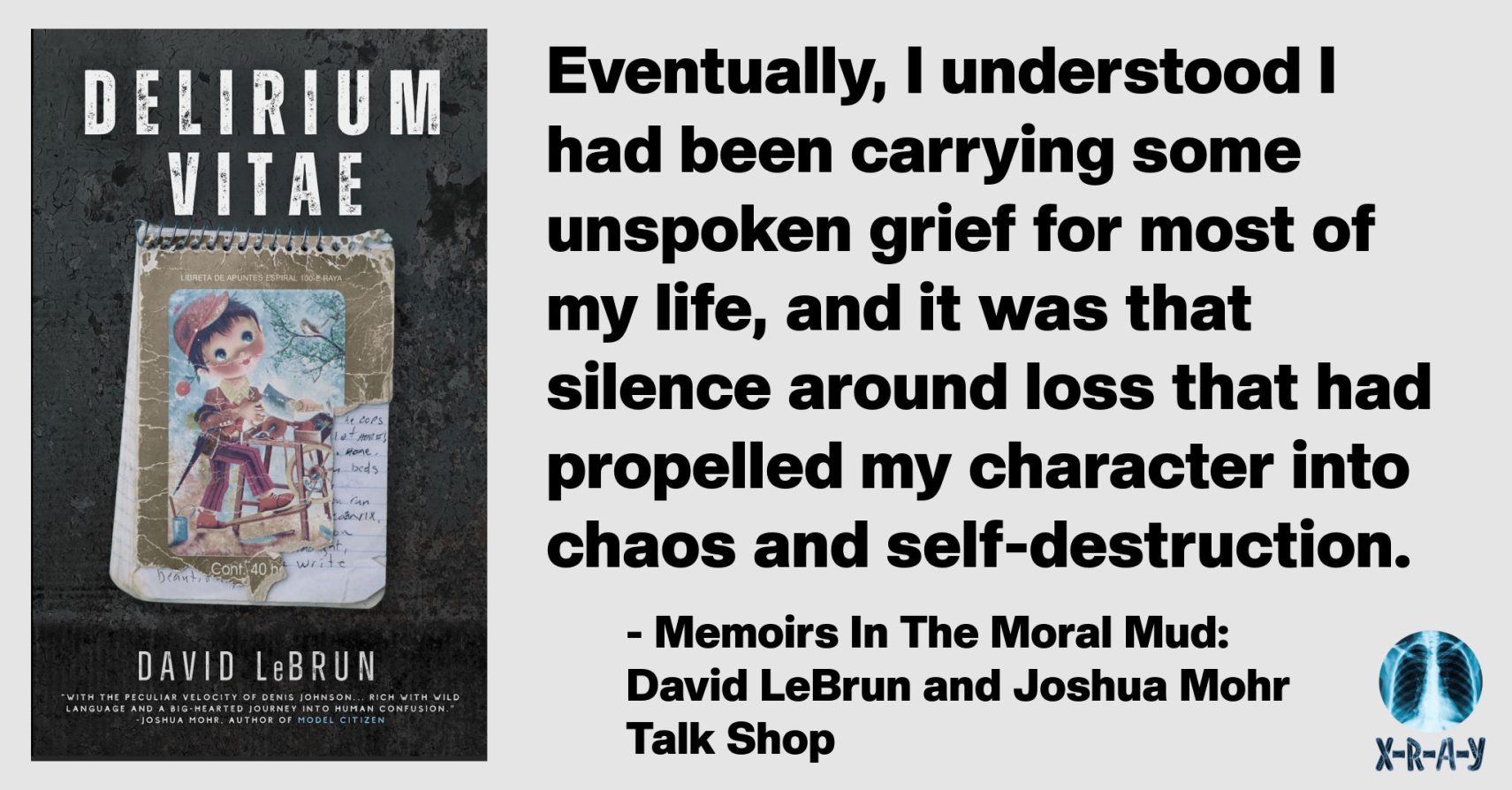

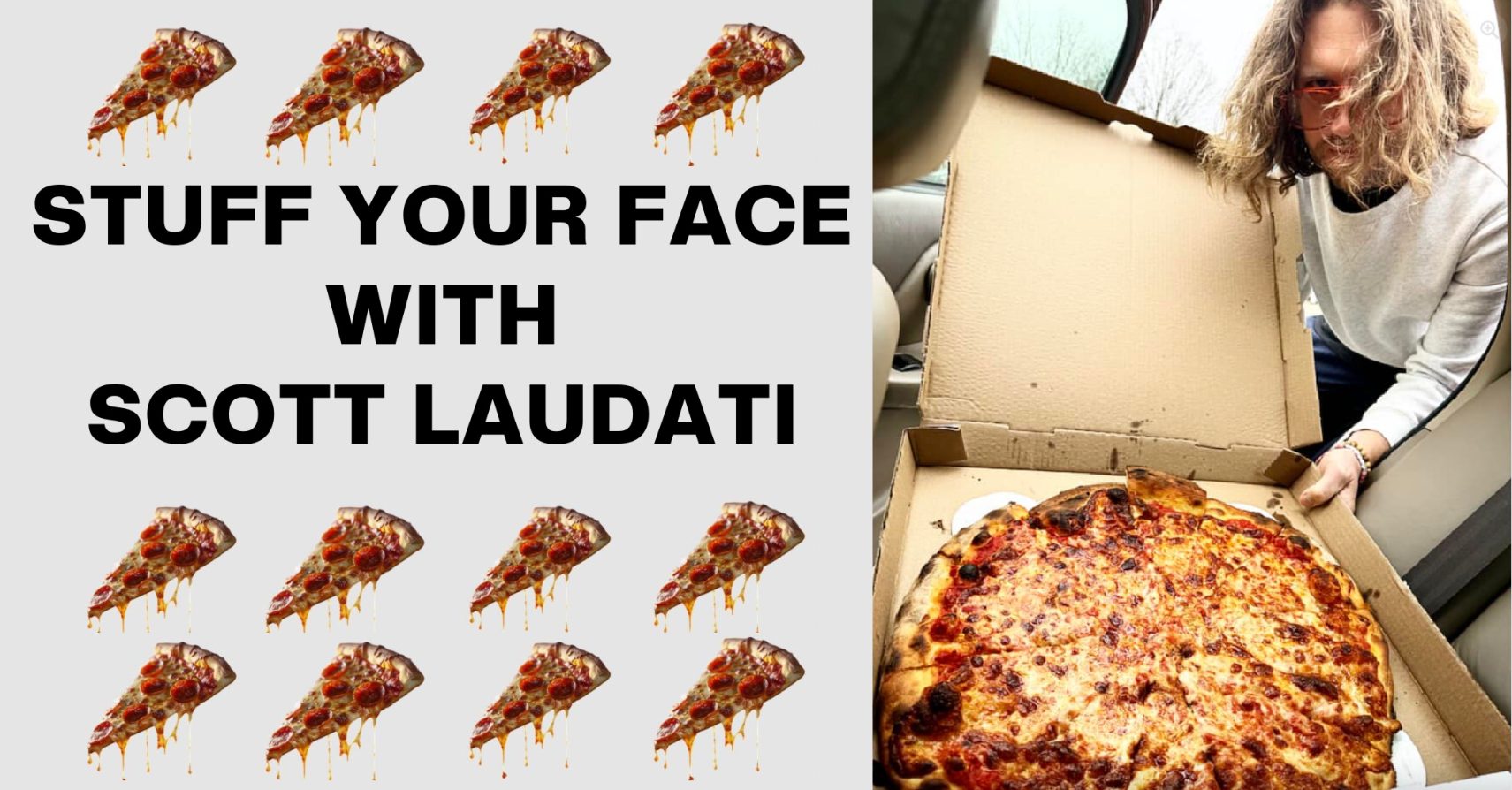
STUFF YOUR FACE WITH SCOTT LAUDATI by Scott Laudati
The Title Fight: Frank Pepe’s VS. Sally’s. New Haven, CT
Once upon a time, back in the closed society that was 1990’s Staten Island, there was a wholesome order. Our fathers grew up in our houses before us and so we ate the same pizza on Friday nights they’d always eaten, because we were still Catholics then, and we didn’t consume meat on Fridays to honor Jesus’ sacrifice of his own flesh. You knew your local pizza guys by name, and if you’d done good in school they’d send you home with a ball of dough to play with, and when it was time for a birthday party you’d order ten pies from them, not the new place down the street with coupons, and you’d sign your tab with a handshake, because trust maintains loyalty, and that kind of thing was really important in those days. But sometimes you had basketball practice across town. And if another father was driving you home you’d stop at his favorite joint, which he’d swear was the best on earth, and you’d be introduced to something totally new. If you went northeast (where the Brooklyn escapees landed), you might end up with a Sicilian pie. If you went closer to Bayonne (Denino’s), no matter who you were with you got the garbage pie (this was an Island favorite). Each neighborhood had something they specialized in, from stromboli to rice balls. There was one constant no matter where you went, though: it was always good. It had to be. The law of the land demanded it.Our fathers were all cops, firefighters, or sanitation workers. Each morning and night they would leave their Alamos and venture to the alien worlds of the other boroughs. I didn’t understand them as separate entities back then, and they were as relevant to me as Nicaragua and Ohio. My dad, like the other dads, had gone to battle in New York City in the ’70s and ’80s, so there was no way they were bringing their families there for a day trip. But, like archeologists going out into the jungle, sometimes they’d return with artifacts. My father was stationed in Little Italy, and every now and then he’d come home with a Lombardi’s pie. Or Tommy The Tank down the street, his dad was up on 125th in East Harlem, and he’d bring home Patsy’s three days a week. So I was always curious about the pizza world beyond my own, because those ovens they used out there in the foreign lands of the City, they were already ancient by 1990, and they did something to a sheet of mozzarella and a thin crust of dough no modern ovens could. I wanted to find the best. And in a world before the internet, word of mouth was the only way to map a trail.Pizza is one of those things that can immediately bond two people that otherwise have nothing in common. More so than even a sports team, because you both know you’re part of the smallest fraternity on earth. I got invited to the birthday party of a painter my age who lived in the backroom of a third story art gallery above a Crown Fried Chicken on the worst block in Newark, NJ. We’d never met before. His girlfriend’s dad was smoking crack out the window and his cat had just stolen one of my cousin’s chicken wings and was growling at anyone who got close. The painter put on a Spumoni Gardens hat, which is like throwing up a gang sign to the right person, and then we teleported to the roof and geeked out about all the legendary slices we’d had over a pack of cigarettes. I had a BA in pizza but this dude was a Doctor. He knew where the basil came from that Di Fara’s used. He had the secret Spumoni Gardens recipe many had died for. And he said something I’d never heard before. He said, “The best pizza comes from New Haven.”
FRANK PEPE PIZZERIA NAPOLETANA New Haven, CTThe lists get longer every year, but the top spots never change. Frank Pepe’s is always first or second. Frank and his wife, Filomena, came to New Haven from Italy in 1920. They spent a few years walking around the Little Italy of Wooster Street selling tomato pies until they could afford a store. In 1925, history was made as Frank Pepe Pizzeria Napoletana opened its doors. It’s hopped back and forth a few times between its current 163 Wooster Street location and the place next door (157 Wooster Street), but the same oven’s been used since 1925. And it’s a beauty. It’s a white tiled coal oven that stretches almost wall to wall, making it more than double what a New York oven could ever be. The original pies didn’t have cheese because there was no refrigeration, so you either got a tomato pie or tomato pie with anchovies. In the 1960s Frank Pepe secured his name in the history books when he invented the clam pie. When I was a kid this specialty was only found in a few restaurants, but now the clam pie is available everywhere, and exists in the cannon up there with pepperoni as one of the few acceptable toppings. The same guy’s been shucking the clams for 40 years. The turnover rate is small. Most of the staff shares the family name. SALLY’S APIZZA New Haven, CTSally’s is the other top spot and they jockey back and forth with Pepe’s. They’re only a few feet away from each other and I guess Sally’s main advantage is that on the one-way street you pass it first. The sign that greets you hanging above the front door immediately pulls you into the family-style tavern. Where Frank Pepe’s clean white pizza oven and kitchen make you feel like you’re going to your Grandparents’ house for a Sunday dinner, Sally’s reminds you of the local bar you’d stop at when you go back to your hometown. The walls are the wood panel of your childhood basement. The floor is a dull brown tile like your friend’s house whose parents still smoked inside. It’s almost as old as Frank Pepe’s but it doesn’t look classic. And it’s still lit by the same stained glass lampshades that hang above pool tables in midwest bars. You can’t ask for a better setting to melt the roof of your mouth and extinguish it with a fountain soda. No one who’s ever sat there has asked for more. There is no more.The Verdict
It would be stupid to declare a winner here. The two best pies on earth exist within half-a-block of each other. They have the same oblong oval shape. They have the same thin crust—well charred but not burnt. The interior of each restaurant feels like two sides of the same home. And the same family is behind both of them (sisters, daughters, and sons bleed through both family trees)! It’s like deciding between your favorite dog or your favorite band. I like Sally’s better, but only by the smallest margin in voting history. And it could just be the novelty. The first few times I went to New Haven, Sally’s had weird hours and it was never open, so I ate a lot of Frank Pepe’s, which blew everything else I’d ever eaten out of the water. But when I finally got ahold of a Sally’s tomato and cheese pie, I felt like I’d bitten into the main conductor of the Universe. It was almost spiritual, a realization that as men we didn't deserve something this good, and yet, whatever’s in charge still decided to give it to us. It was The Holy Grail. Now that you know you’re in good hands at either Pepe’s or Sally’s, I’ll give you some advice. Back when I started going to New Haven you could get a table and eat inside. If you attempt to do this now you will ruin the experience, because you’ll be waiting and starving for hours. Call ahead and order your pie at least an hour early. You’ll see the word APIZZA everywhere, it’s pronounced “ah-beetz,” but if like me, you feel stupid saying that, you can tell the nice lady on the phone you want a “Large tomato and cheese pie.” When you arrive you’ll see a line in front (this goes for both Sally’s and Pepe’s). These are the people waiting to dine inside and they’ll be there forever. Walk right past them (they’ll be mad), and enter. A kid will be sitting at a table. Tell him you want to pay cash. He’ll send you inside the restaurant and you’ll have a minute or two to look around, take a quick picture, marvel at that ancient wonder of a pizza oven, and then you’ll get your pizza. On the way out that kid who sent you in will have a bucket of plates, cutlery, and napkins. Give him a small tip, take what you need, and then head back out. There’s a great little park in-between Sally’s and Pepe’s with a bench you can sit and eat. Or, you can go one block north to Wooster Square Park, a beautiful brownstone-lined patch of grass no one is ever at and eat your pizza in peace, looking up between bites at some of the only original architecture left in a city that used to be known for its elegance and gentry. The real winner of the pizza wars is New Haven. My head still shakes every time I say that. Follow Scott’s international adventures, food-based and otherwise, on his YouTube channel.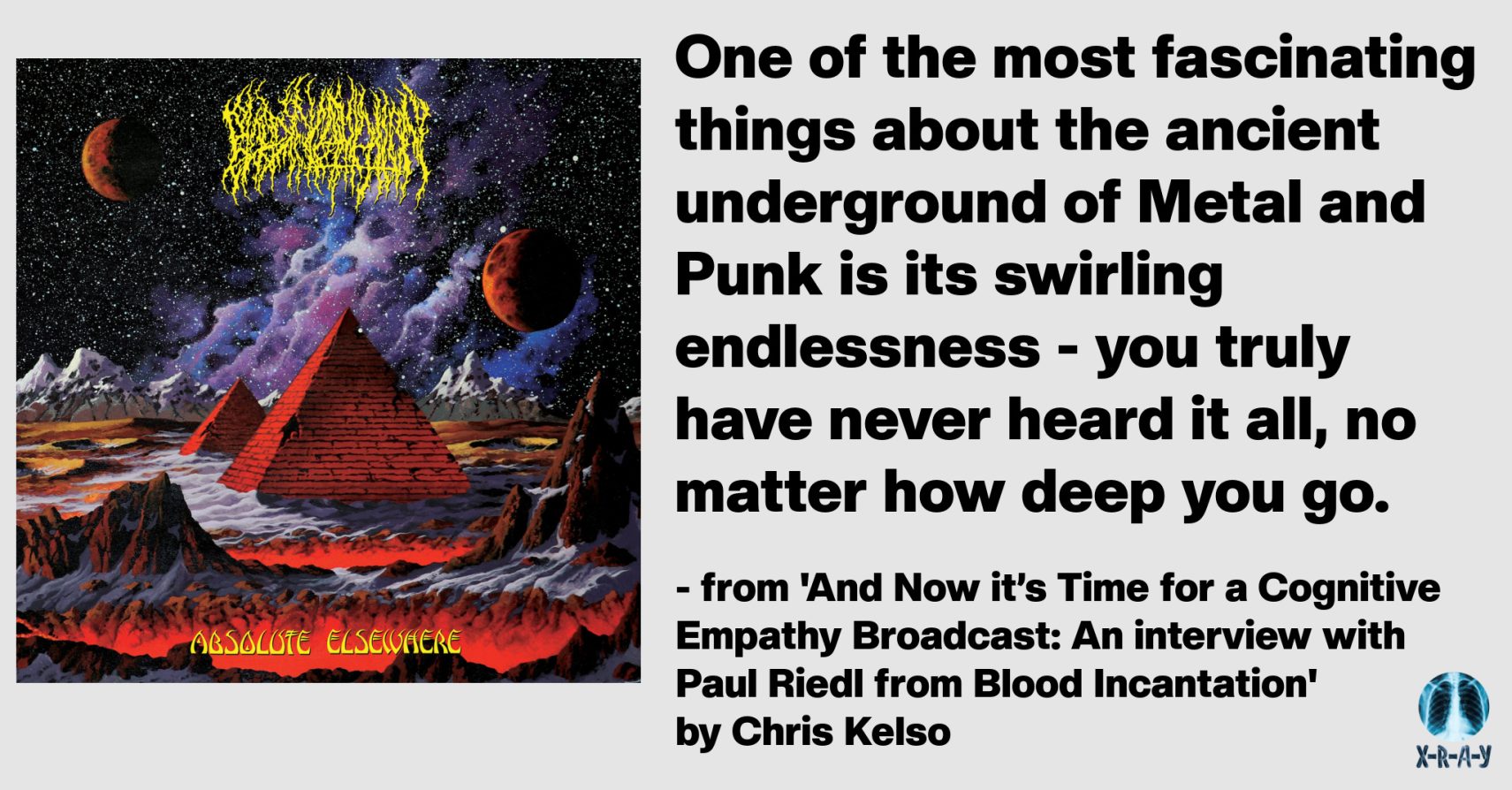
AND NOW IT’S TIME FOR A COGNITIVE EMPATHY BROADCAST: AN INTERVIEW WITH PAUL RIEDL FROM BLOOD INCANTATION by Chris Kelso

FAULKNER DIDN’T GIVE A SHIT ABOUT TEMPORAL INCONSISTENCIES, SO WHY SHOULD I?: AN INTERVIEW WITH JOHN WADDY BULLION by Kirsti MacKenzie

THE ANSWER HAS TO BE YES: AN INTERVIEW WITH KIRSTI MACKENZIE by John Waddy Bullion
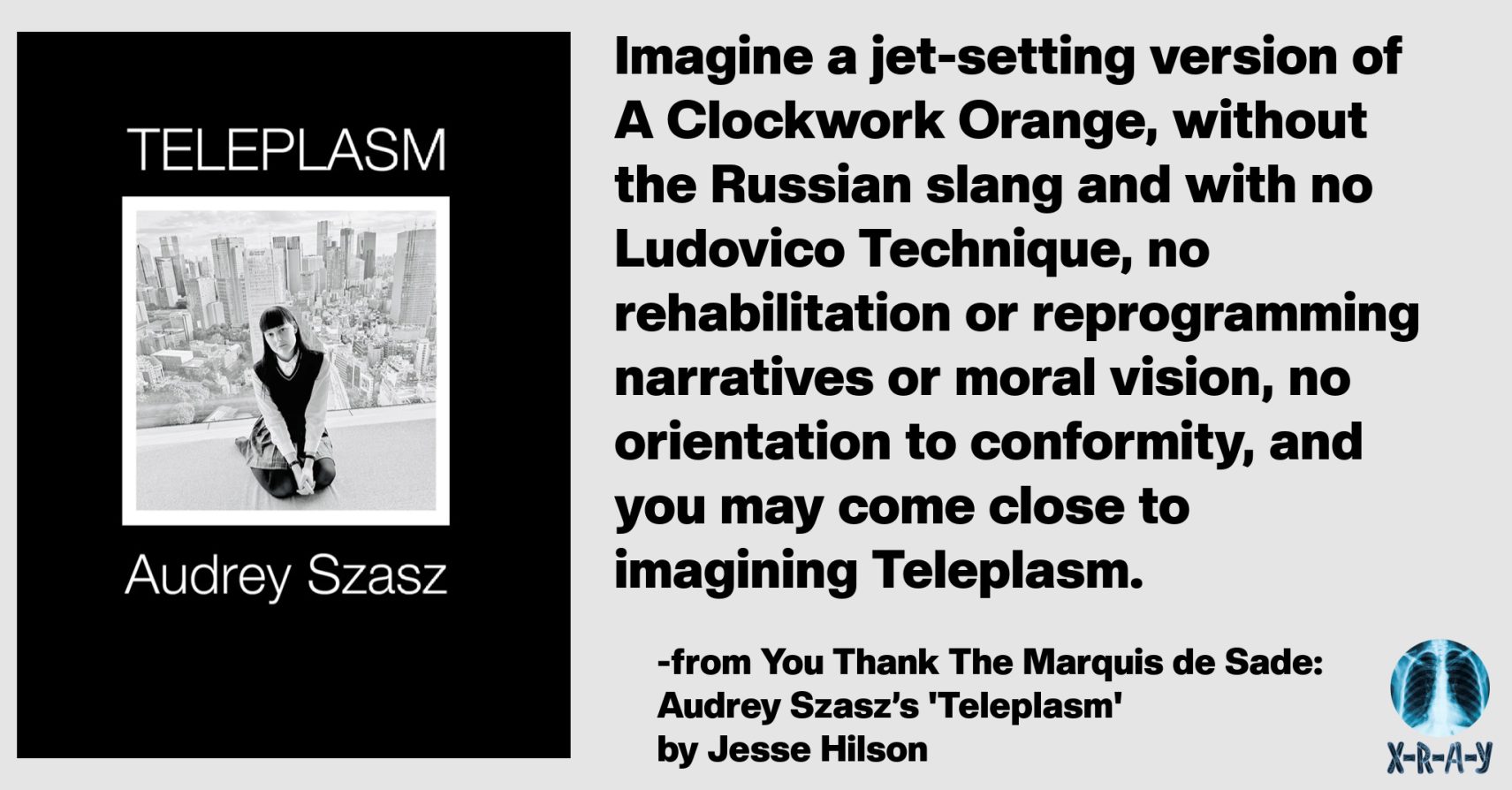
YOU THANK THE MARQUIS DE SADE: AUDREY SZASZ’S ‘TELEPLASM’ by Jesse Hilson
My wish for affection is part of a larger neurotic trend, put in motion by an artificial hand or a silent motor—eternity is an unwound thread from an invisible spool—…and what am I doing right now? I am imitating a masochistic patient who longs to be trussed up in my cell like a worm in ever-tightening restraints, disobeying verbal and written commands, slacking off, twisting and turning, prophylaxis as state oppression, I need to please a white man, a clearly ironic overtone of hypergenocidal mania, sexual relations with my oppressors, analysts, teachers, furtive incest wishes, involuntary recall of trauma injuries, furious self-flagellation that never seems to satisfy…Imagine a jet-setting version of A Clockwork Orange, without the Russian slang and with no Ludovico Technique, no rehabilitation or reprogramming narratives or moral vision, no orientation to conformity, and you may come close to imagining Teleplasm. The narrator’s voice (this is a common feature of all Szasz’s fiction that I’ve read) is overpowering: sophisticated and urbane while at the same time uniquely dissolute and down for whatever, including felonious criminal behavior and flouting all forms of authority. This makes for a fascinating window onto her characters. The boundaries broken are both external and internal. Szasz’s narrators dare you to develop something as frail and weak as a moral objection, or a set of stupid moral reactions, to their litanies of outrage and danger.I had opened myself up to Teleplasm maximally, so the book stood for something significant, to me. I could play along with the morbid curiosity. When I read it, though, I felt like “There, I’ve read enough of the evil.” A good book in many ways, an evil book in a big way, in the biggest way. Teleplasm should not be banned as a matter of policy, but if you’re looking for books that from an enlightened and amused perspective “might as well be banned,” banned by a smirking individual, not a humorless, illiterate group, banned for one’s self, this is something like that book. It is a turn-off for all further books of its type about that kind of moral degeneracy. And there are a lot of books of the type out there, but none as well-written as Teleplasm, I’d wager. In it, I have found the book that has done the turning off for me. Szasz’s cool, black book has pride of place in my library.When I first read it, I gave it a five-star Goodreads review, deservedly, but on a personal evaluative basis, as a reader, it’s something I didn’t know if I ever wanted to read again. But I did read the book, again, later, months later, to taste and savor the moral viewpoints upon reflection. Part of this faculty of judgment was arrived at by reading several of Szasz’s novels and novellas, and feeling like I had seen enough of the progression of subject matter to get the picture and not needing to go further. I’m not 100% sure there’s much more depth to the cistern than what I saw from Counterillumination, Invisibility: A Manifesto, “A-Z of Robomasochism,” and finally Teleplasm. Szasz has written numerous other books that if one had extra cash and a desire to read further (itself a species of masochism, arguably), one could buy those books and explore it all. It feels like a case of clever craftsmanship and enfant terrible wit utilized on subject matter with diminishing returns.This repulsion is “satisfying” in a way, a sad satisfaction for a reader. Sad that it was necessary. But happy too, in that I can move on to investigating other moral territories in literature. It drove me, in a sense, out of Dennis Cooper’s best-of lists at year’s end and into the arms of …some more positive sensibility. I don’t know the Marquis de Sade enough to place him, but you thank Sade, you thank him for drawing the boundary. I no longer believe for me “there is no boundary.” Szasz, and in one sense, Sade as one of her influences as a writer of S&M erotica and venom spat into the collective face of the squares, illustrated that, not for themselves or for their thirsty, depraved readers, but for me. And I’m just one reader and nobody to heed. I might as well, however, find a philosophy or a utility in Teleplasm. It provides a service, an aesthetic object lesson: an example of morality and aesthetics meeting perfectly in a novel. If it’s a Sadean thing, I wouldn’t say it draws me closer to reading the French aristocrat. Notoriety is only so compelling — beyond a certain point it has no power over “good people,” people with some orientation, as Joris-Karl Huysmans found after writing his own horrid books, towards the Cross. I hate to sound like a Midwestern mom at a school board invoking Satanic Panic. I don’t think that’s me. I don’t know if I need to read more Audrey Szasz in a quest to gain the forbidden knowledge. And I don’t think this was ever her goal as a writer. The thing about quitting reading her for the kicks is that there is always the world’s horror reportage of its own evil you can turn to. Artists can give you so much of the picture and are in the end, interchangeable with each other. Szasz’s writing was a unique piece of the puzzle; her books, if they were living things, would have zero remorse, zero pangs of conscience about their capabilities. If there was a satirical vein in Teleplasm meant to invite a more complex moral reading, it was too Baroque for me to detect. Maybe I was too much of an obtuse normie to read, in the comedy of Sloane Epstein’s monologues, some cry for help, something about the need for love? It is a damaging, upsetting watershed of a book. I don’t think I’m interested in that kind of damage anymore. I could have gone on reading other transgressive and nihilistic authors forever, presumably. Again, I’m grateful to Teleplasm’s author for helping me to shut off the nozzle.The Marquis de Sade, it seems to me, served as a “necessary outlier” to position other philosophical, moral, and literary coordinates around, against which normalized values can and must be established. And yet the world seems by some lights (whether subjective or objective, whether localized perceptions or mediated global consciousness) to be well on the way to becoming more Sadean every day, not so much of an outlier anymore. Maybe here’s another value of Teleplasm. It’s a dishonest, ill-equipped critic who hasn’t read Sade yet invokes him, but I don’t really need to read him to get this: I have Audrey Szasz’s updated writing.

WORD HORNY: JACK SKELLEY RECOMMENDS
Which is why I stand before you nowproof of boththe glories of capitalismand the truthof dialectical materialismGet Glop today! Amy Gerstler, Is This My Final Form? (Penguin Poets, 2025)Amy Gerstler is America’s greatest living lyric poet. There, I said it. A perfect example is this book’s “Night Herons,” which appeared also in The New Yorker and represents Gerstler’s specialty: the dramatic (comic) monolog. So, no surprise this volume also veers into dramatic works. (“Siren Island.”) I’ve seen her miraculous/weird plays rendered on stage. They’re a corollary pleasure on the page. Rosie Stockton, Fuel (Nightboat, 2025)There are (they say) two parts of a metaphor: The “tenor” (meaning) and the “vehicle” (the image that carries it). The verse of Fuel drives the vehicle of desire – literal and symbolic, internal and societal. In a Lit Hub essay Stockton compresses the book’s rich power poetics: “According to Lacan’s update to Freudian psychoanalysis, all drives operate at the speed of the death drive. The death drive is a mistaken longing for pre-Oedipal harmony that fuels the coherence of our symbolic order, mediating between life and death. But as every Orphic driver knows, this has more to do with our quest to cohere meaning in our symbolic worlds than biological instincts. For better or for worse, the drive is a series of detours that lets us speed toward and circle around the enjoyments of life that we, in a world that is literally running out of gas, don’t have the energy for. Not literally death, but the deadness we intercept driving close to the guardrails. The drive circuits around what keeps us alive, beyond mere self-preservation. The proof is in the poetry: the death drive, actually, is on the side of life.” Olivia Kan-Sperling, Little Pink Book: A Bad Bad Novel (Archway Editions, 2025)What is it? A meditation on a color. A bilingual fable. A confection of cuteness. A yummy gummy romance. A takedown of Asian girl-pop machinations. Little Pink Book is also something impossible: an exaltation of the power of “sentimental” melodies/lyrics. (Have you ever had a sappy song trigger a deep cry?) Pretty word-worlds cuddle you weirdly: “Having been injected into this bubble-gum bubble, Limei felt cold, slow, sticky. This usually sweet and nice shade – the color of girls and fun – felt, suddenly, claustrophobic. Pink was also the color of insides, and this was too much, too much inside.” Amid the mash of forms is narrative, complete with horny/porny parts. Is it all in little Limei’s mind? Kan-Sperling is a virtuosa of multiple styles. Cum PunkA gorgeously gooey online anthology, Cum Punk proclaims: “Cum is in-your-face life energy. We are here to blow loads and do big juicy squirts in the faces of sex neurosis, prudish pretension, and desire-dementing repression. Gone are the days of self-leaving, disembodied cums. Now is the time of fully embodied, self-arriving cums! We bust through fear and shame as hard as we bust our finest, most violent nuts.” Ashley D. Escobar, GLIB (Changes Press)The NY School of Poetry is in good hands... and mouths. Validating generational elasticity, Escobar’s Glib references Frank O'Hara, but instead of “i do this, i do that” it’s “i fuck this, i snort that.” Laffs and schemes and senses and dreams, and sexuationships, thick with references... totally IN THE MOMENT. Poetry is not ABOUT something; it IS that thing. “Thingness,” as Eileen Myles posits in the intro. Plus, any book that rags on Sally Rooney & includes lines like, “your dick is my favorite toy” gets extra points.
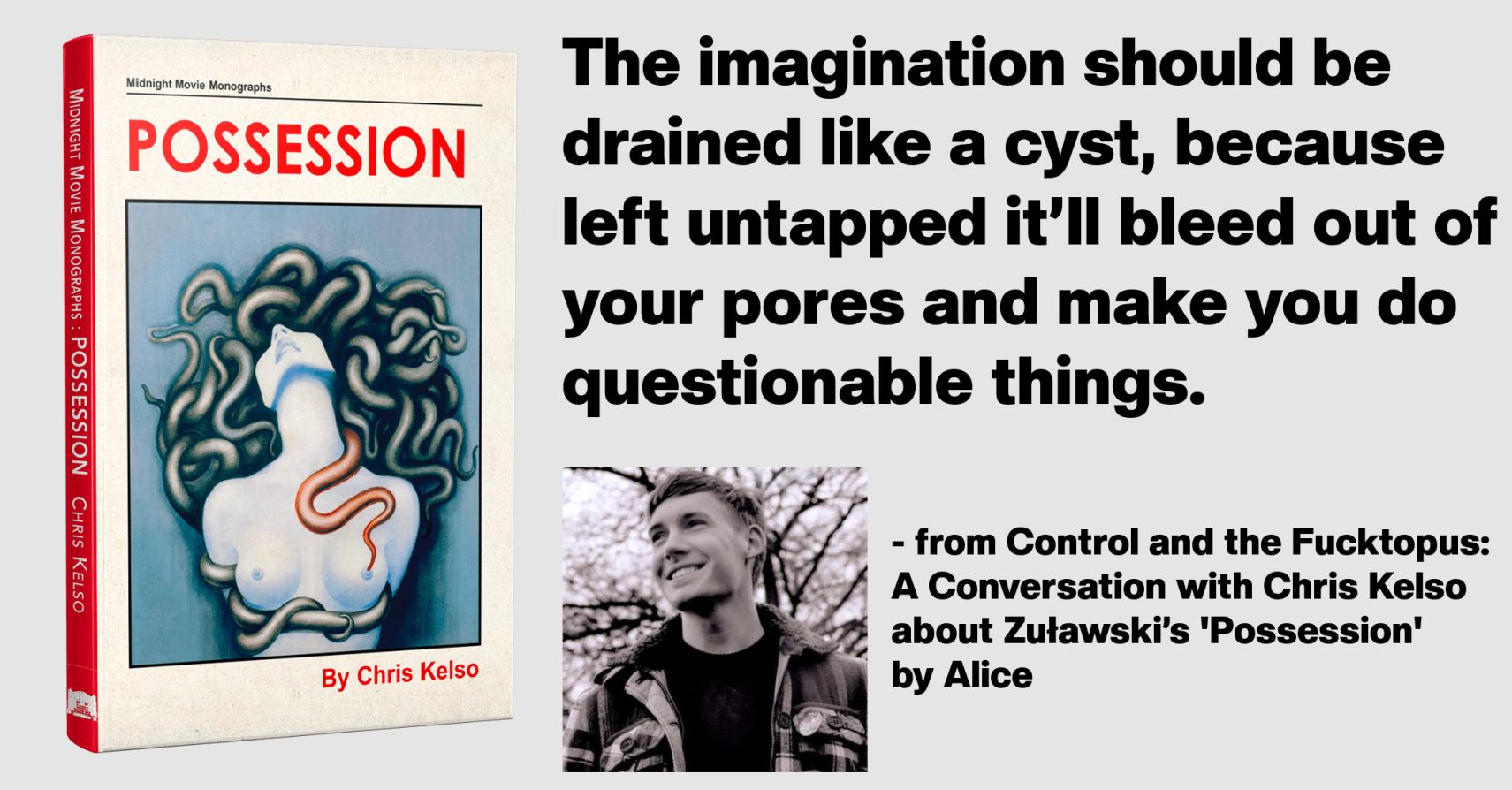
CONTROL AND THE FUCKTOPUS: A CONVERSATION WITH CHRIS KELSO ABOUT ŻUŁAWSKI’S ‘POSSESSION’ by Alice
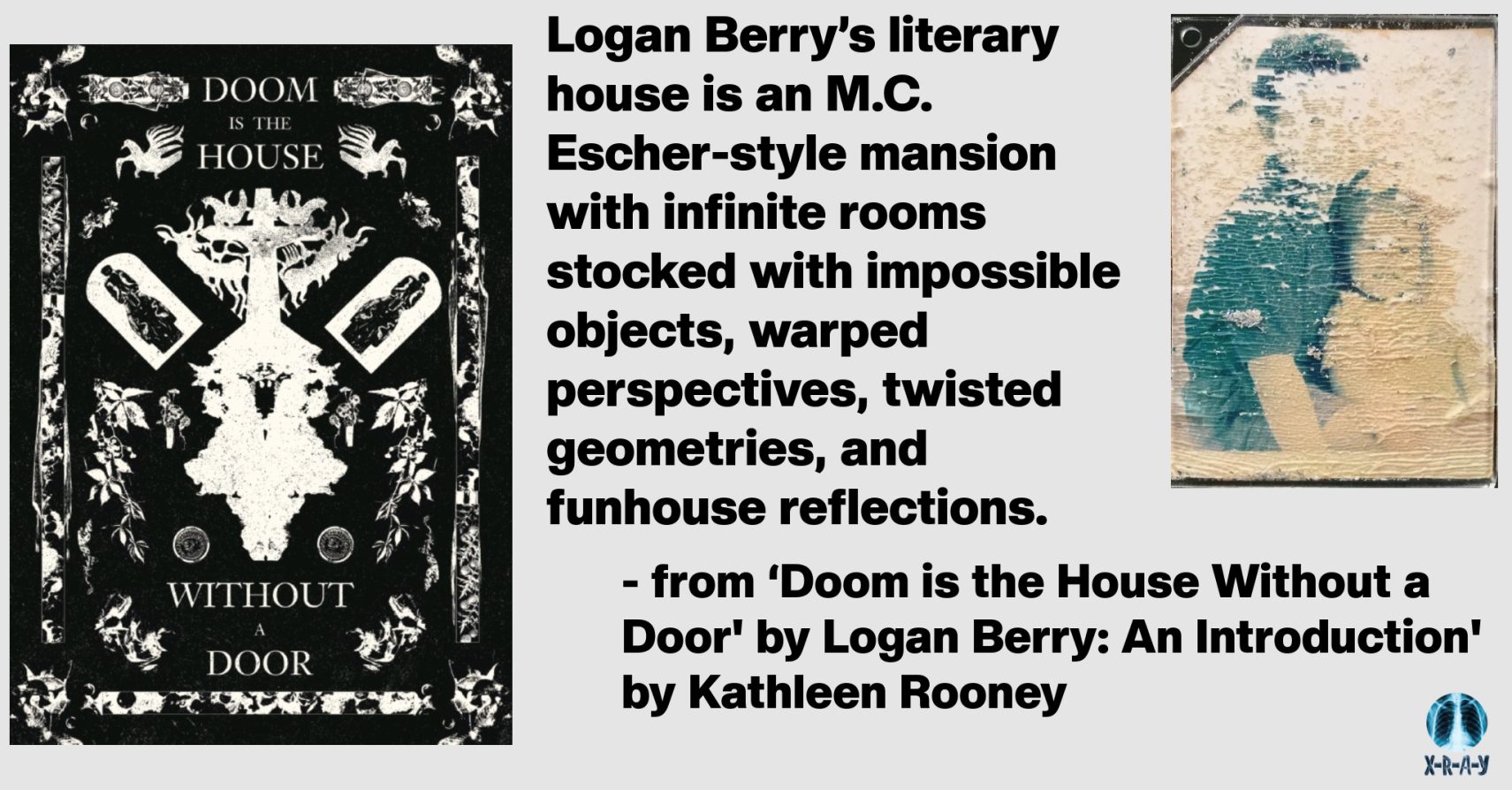
‘DOOM IS THE HOUSE WITHOUT A DOOR’ BY LOGAN BERRY: AN INTRODUCTION by Kathleen Rooney
Doom is the House without the Door—‘Tis entered from the Sun—And then the Ladder's thrown away,Because Escape—is done—
Logan Berry’s literary house also has no door, but not in the sense that one is trapped inside by walls lacking egress. Rather, nothing blocks this house’s threshold because the builder wants us to walk in and snoop.
Logan Berry’s literary house is an M.C. Escher-style mansion with infinite rooms stocked with impossible objects, warped perspectives, twisted geometries, and funhouse reflections.His literary house is a Piranesi drawing come to life, rife with endless staircases, akin to that artist’s Imaginary Prisons, full of subterranean vaults and extreme machines and round towers and men being stretched on the rack and grand piazzas lit with smoldering fires and connected with drawbridges and gothic arches, hung with rusty chains and scented with fetid wells and decorated with monsters in bas-relief.Logan Berry’s literary house is in every sense of the word a capriccio; in English a caprice—an architectural fantasy that puts new buildings and archaeological ruins and other artifacts and detritus in fantastical combinations that gratify the artist and intrigue the viewer with their dreamlike juxtapositions and liberty of imagination. One etymology for capriccio is that it derives from the Italian for the unpredictable movements and behaviors characteristic of a juvenile goat, suggesting that the work should be as freakish and mercurial as the artist can make it.Logan Berry’s literary house is a structure only partly built, but currently without end, an edifice that will keep growing until he either stops (perish that thought) or dies (perish that too, but everyone perishes).The oldest email exchange between myself and Logan that I could find is from January of 2014. He was a student in my intro to Creative Writing class at DePaul. Everyone had to write an elegy and Logan’s, addressed to his sister and called, “I Will Die Lex,” was so promising that I asked his permission to share it with the class and I’ve been a fan ever since. It ended:Death staked His claimLike Columbus and his flag España.Fingers trace the entry,Sting sings.
Hand thrown aside.My body, a stepping-stone in the slush.Soot Sunset.
That was the open door I walked through to commence my tour of Logan Berry’s literary house. I feel lucky that I’ve got Transmissions to Artaud (Selffuck, 2020), Run-off Sugar Crystal Lake (11:11 Press, 2021), Casket Flare (Inside the Castle, 2023), Ultratheatre: Volume 1 (11:11 Press, 2024) and now Doom. About this room of the building, I have written: “A visual and verbal fantasia of money, meat, and misery, Logan Berry’s Doom Is the House Without a Door dances to the demonic, infernal rhythms of the 21st century. To look into this book’s gargoyle face is to risk allowing it to reap your soul. Its phantasmagoria of fucked-up fatherhood makes voyeuristic perverts of us all.” Logan Berry’s literary house is perpetually under construction, a kind of Winchester Mystery House, never-ending and mystifying: why did the creator do this? His literary house is above all a memory palace of things he cannot forget. Once we visit, we cannot forget them either.“Nature is a haunted house—but Art—a house that tries to be haunted.” Emily Dickinson wrote that in a letter to Thomas Wentworth Higginson in 1876.Logan Berry’s literary house is haunted. Long may he haunt.